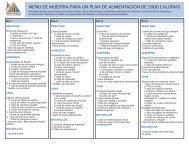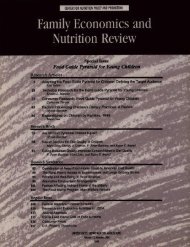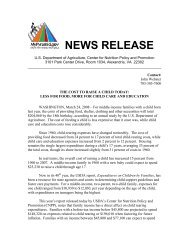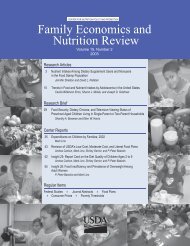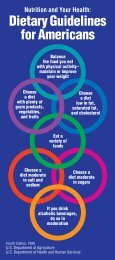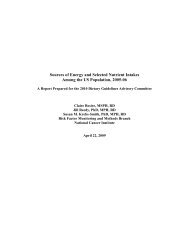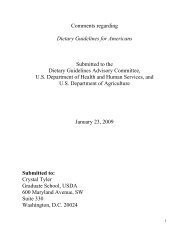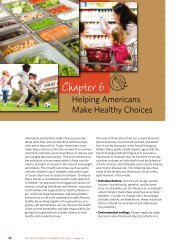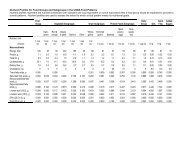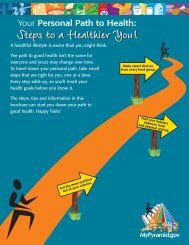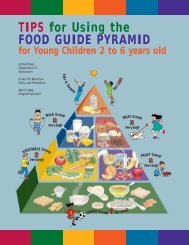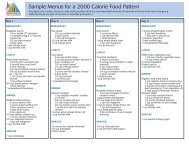Elderly Nutrition - Center for Nutrition Policy and Promotion - US ...
Elderly Nutrition - Center for Nutrition Policy and Promotion - US ...
Elderly Nutrition - Center for Nutrition Policy and Promotion - US ...
You also want an ePaper? Increase the reach of your titles
YUMPU automatically turns print PDFs into web optimized ePapers that Google loves.
Scaling Analysis: Do the <strong>Elderly</strong><br />
<strong>and</strong> Nonelderly Experience<br />
<strong>and</strong> Respond Similarly to<br />
Food Insecurity?<br />
To assess whether the questions in the<br />
Food Security Scale are understood<br />
similarly by the elderly <strong>and</strong> the nonelderly<br />
<strong>and</strong> whether they experience<br />
<strong>and</strong> respond similarly to food insecurity,<br />
I compared response patterns<br />
of elderly-only <strong>and</strong> nonelderly households.<br />
To do so, I used statistical<br />
methods based on the Rasch measurement<br />
model—the methods originally<br />
used to develop the Food Security<br />
Scale. This analysis exploits one of<br />
the strengths of multiple-indicator<br />
measures such as the Food Security<br />
Scale: associations among the indicators<br />
comprising the scale provide<br />
evidence of its validity <strong>and</strong> reliability.<br />
Furthermore, if the patterns of association<br />
among the items in a multipleindicator<br />
measure are similar in two<br />
populations, this suggests that the items<br />
relate similarly in the two populations<br />
to the underlying phenomenon that<br />
accounts <strong>for</strong> their interrelationships;<br />
that is, the items measure the same<br />
phenomenon in the two populations.<br />
These methods of scale assessment<br />
are more widely used in psychometric<br />
research <strong>and</strong> educational testing than<br />
in nutrition <strong>and</strong> economic research, so<br />
I present first a brief summary of the<br />
Rasch model <strong>and</strong> the scale assessment<br />
statistics based on it. More detailed<br />
in<strong>for</strong>mation on the Rasch model <strong>and</strong><br />
associated statistics is available<br />
elsewhere. 1<br />
1<br />
See Wright (1977; 1983), Wright & Masters<br />
(1982), Baker (1992), Hambleton, Swaminathan,<br />
& Rogers (1991), <strong>and</strong> Fischer & Molenaar<br />
(1995), <strong>and</strong> the Website of the MESA<br />
psychometric laboratory at the University<br />
of Chicago at www.rasch.org. In<strong>for</strong>mation<br />
about applications of Rasch methods to the<br />
development <strong>and</strong> assessment of food security<br />
scales is available in Hamilton et al. (1997a;<br />
1997b), Ohls, Radbill, & Schirm (2001), Bickel<br />
et al. (2000), <strong>and</strong> Nord (2000).<br />
An essential characteristic of the Food<br />
Security Scale is that the items comprising<br />
it vary across a wide range of<br />
severity of food insecurity. The precise<br />
severity level of each item (the “item<br />
calibration” or “item score”) is estimated<br />
empirically from the overall<br />
pattern of response to the scale items by<br />
the interviewed households. However,<br />
the range of severity of the conditions<br />
identified by the items is also intuitively<br />
evident from inspection of the items.<br />
For example, not eating <strong>for</strong> a whole<br />
day is a more severe manifestation of<br />
food insecurity than is cutting the size<br />
of meals or skipping meals. These<br />
differences in severity are observed<br />
in two ways in the response patterns<br />
of surveyed households.<br />
First, more severe items are less<br />
frequently affirmed than less severe<br />
items. Second, households that affirm<br />
a specific item are likely to have also<br />
affirmed all items that are less severe,<br />
while households that deny the item<br />
are likely to also deny all items that<br />
are more severe. These typical response<br />
patterns are not universal, but they are<br />
predominant, <strong>and</strong> among households<br />
that do deviate from the typical<br />
patterns, the extent of deviation<br />
tends to be slight.<br />
The Rasch model <strong>for</strong>malizes the<br />
concept of severity-ordering of items<br />
<strong>and</strong> provides st<strong>and</strong>ard statistical<br />
methods to estimate the severity level<br />
measured by each item <strong>and</strong> the severity<br />
level experienced by each household.<br />
The model also assesses the extent to<br />
which the response patterns observed<br />
in a data set are consistent with the<br />
severity-order concept. The food<br />
security of households can be thought<br />
of as a continuum, which is represented<br />
by a graduated scale, from fully secure<br />
to severely insecure with hunger<br />
evident. The Rasch model links the<br />
severity of items to this same scale as<br />
follows: Imagine a household becoming<br />
progressively more food-insecure. At<br />
very low levels of food insecurity, the<br />
household denies all items in the Food<br />
Security Scale. As insecurity increases,<br />
the household reaches a level where it<br />
begins to report, “We worried whether<br />
our food would run out be<strong>for</strong>e we got<br />
money to buy more” (the least severe<br />
item in the scale), while continuing to<br />
deny the more severe items. That low<br />
level of insecurity is the severity score<br />
of the “worried” item.<br />
At some more severe level, the household<br />
begins to report, “The food we<br />
bought didn’t last, <strong>and</strong> we didn’t have<br />
money to get more,” while continuing<br />
to affirm the “worried” item but<br />
denying all of the more severe items.<br />
This higher severity level is the severity<br />
score of the item “Food we bought<br />
didn’t last.” Of course, not all households<br />
experience or report food security<br />
in exactly the same manner, so these<br />
relationships are only probablistically<br />
true. Technically, half of all households<br />
with severity scores equal to that of an<br />
item will affirm that item. That is, the<br />
average household at this level of<br />
severity is right on the edge, equally<br />
likely to say “yes” or “no” to the item.<br />
As a household becomes more foodinsecure,<br />
it is progressively more likely<br />
it will affirm each item. The Rasch<br />
model is based on a specific mathematical<br />
function that relates the probability<br />
of a household affirming an item<br />
to the difference between the severitylevel<br />
of the household <strong>and</strong> the severity<br />
score of the item (box 1). Average item<br />
discrimination <strong>and</strong> item-fit statistics,<br />
used in this study to compare response<br />
patterns of elderly <strong>and</strong> nonelderly<br />
households with questions in the Food<br />
Security Scale, are based on the<br />
consistency with which households’<br />
responses con<strong>for</strong>m to this expected<br />
pattern. These statistics are based on<br />
the proportions of expected <strong>and</strong><br />
unexpected responses. Expected<br />
responses are denials of an item by<br />
households with severity scores below<br />
2003 Vol. 15 No. 1 35



